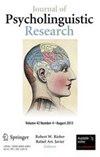什么词?儿童普通话中的存在量词还是通用量词?
摘要
Wh-words 被分析为存在量词(Chierchia,载于《语法中的逻辑:极性、自由选择和干预》。牛津大学出版社,牛津,2013 年;Fox, in Sauerland U, Stateva P (eds) Presupposition and implicature in compositional semantics (Palgrave studies in pragmatics, language and cognition).Palgrave MacMillan, Houndmills, pp 71-120, 2007; Liao in Alternative and exhaustification: Non-interrogative uses of Chinese wh-words.哈佛大学,2010 年)或通用量词(Nishigauchi, in:神户松荫的理论和应用语言学 2》,神户松荫语言科学研究所,1999 年)。这两种说法对儿童最初如何解释 wh-words 有不同的预测。普遍说认为,儿童最初应将wh词解释为普遍量词,而存在说则认为,儿童一开始应将wh词解释为存在词。为了对这两种说法进行评判,本研究旨在探讨学前儿童对wh-量词的语义知识。具体来说,本研究以 4-5 岁的普通话儿童和对照组成人为对象,调查了他们对wh-词shenme "什么 "的解释。研究使用了 "真值判断任务"(Crain 和 Thornton,《通用语法研究:语法和语义习得实验指南》,麻省理工学院出版社,剑桥,1998 年)。麻省理工学院出版社,剑桥,1998 年),实验 1 评估了在 ruguo "如果 "条件句的前置句中,儿童对 wh-word shenme "什么 "的解释是否更接近极性敏感词 renhe "任何 "或通用量词 suoyou "所有 "的意义。实验 2 和 3 采用问答任务,分别研究了儿童在两类问题(带质点 ma 的是-否问题和 A-not-A 问题)中是否会将 shenme "什么 "解释为与 renhe "任何 "或 suoyou "所有 "的意义更接近。研究发现,儿童和成人在解释 shenme "什么 "时,都认为它比 suoyou "所有 "在意义上更接近 renhe "任何"。研究结果表明,说普通话的学龄前儿童已经拥有与成人类似的wh-量词语义知识:wh-词是存在量词,而不是普遍量词。由于初级语言输入的匮乏,儿童对非指代性 wh-words 的早期掌握似乎支持语言习得的生物语言学方法(乔姆斯基在《句法理论的各个方面》(Aspects of the theory of syntax.麻省理工学院出版社,剑桥,1965 年;Pinker,《语言可学性与语言发展》。哈佛大学出版社,剑桥,1984 年;Crain 等人在《从生物语言学角度看语言习得》中。Neurosci Biobehav Rev, 2016. https://doi.org/10.1016/j.neubiorev.2016.09.004 )。

Wh-words have been analysed as existential quantifiers (Chierchia in Logic in grammar: polarity, free choice, and intervention. Oxford University Press, Oxford, 2013; Fox, in Sauerland U, Stateva P (eds) Presupposition and implicature in compositional semantics (Palgrave studies in pragmatics, language and cognition). Palgrave MacMillan, Houndmills, pp 71-120, 2007; Liao in Alternative and exhaustification: non-interrogative uses of Chinese wh-words. Harvard University, 2010) or universal quantifiers (Nishigauchi, in: Theoretical and applied linguistics at Kobe Shoin 2, Kobe Shoin Institute for Linguistic Sciences, 1999). These two accounts have distinct predictions on how children initially interpret wh-words. The universal account predicts that children should initially interpret wh-words as universal quantifiers, whereas the existential account anticipates that children should start out with the existential interpretation. To adjudicate between the two accounts, the present study was designed to explore pre-schoolers' semantic knowledge of wh-quantification. Specifically, it investigated the interpretation of the wh-word shenme 'what' with 4-and 5-year-old Mandarin-speaking children and a control group of adults. Using a Truth Value Judgment Task (Crain and Thornton in Investigations in universal grammar: a guide to experiments on the acquisition of syntax and semantics. MIT Press, Cambridge, 1998), Experiment 1 evaluated whether children interpret the wh-word shenme 'what' as closer in meaning to the polarity sensitive item renhe 'any' or the universal quantifier suoyou 'all' in the antecedent of ruguo 'if' conditionals. Using a Question-Answer Task, Experiments 2 & 3 respectively investigated whether children interpret shenme 'what' as closer in meaning to renhe 'any' or suoyou 'all' in two types of questions: yes-no questions with the particle ma and A-not-A questions. It was found that both children and adults interpret shenme 'what' as closer in meaning to renhe 'any' than suoyou 'all'. The findings suggest that Mandarin-speaking pre-schoolers already have adult-like semantic knowledge of wh-quantification: wh-words are existential quantifiers rather than universal quantifiers. Due to the paucity of primary linguistic input, children's early mastery of the non-interrogative wh-words appear to support the biolinguistic approach to language acquisition (Chomsky in Aspects of the theory of syntax. MIT Press, Cambridge, 1965; Pinker in Language learnability and language development. Harvard University Press, Cambridge, 1984; Crain et al. in Language acquisition from a biolinguistic perspective. Neurosci Biobehav Rev, 2016. https://doi.org/10.1016/j.neubiorev.2016.09.004 ).

 求助内容:
求助内容: 应助结果提醒方式:
应助结果提醒方式:


